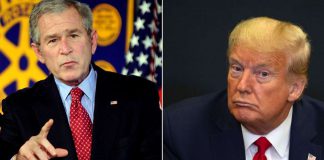JULY 3, 2019

BERLIN — When President Trump returned from the French Bastille Day military parade in July 2017, he was enamored by the display, calling it “one of the most beautiful parades I have ever seen.”
Months later, Trump made a decision: He wanted his own parade. Ideally, a bigger and better show than the one he had watched in Paris. “We’re going to have to try and top it,” he said.
On July Fourth, his plans to display military might will come to fruition during expanded Independence Day celebrations on the Mall, dubbed the “Salute to America” — complete with the deployment of tanks and fighter jet flyovers.
Trump’s plans have caused consternation in the United States, with some people calling the sight of tanks on Washington’s streets grotesque. Around the world, analysts and observers have recoiled at the suggestion that Trump’s spectacle is in line with other democracies who celebrate their military history with gravity and reflection on the horrors of war.
These analysts say the tenor of Trump’s “Salute to America” has more in common with the garish and muscular public ceremonies held by autocratic regimes like Russia, North Korea and China.
“The U.S. president uses the anniversary of his country for his own propaganda,” Germany’s influential Tagesspiegel newspaper in Berlin said in a commentary on Wednesday, which branded Trump’s plans as “shameless” and a “show of egoism.”
Other European analysts said what distinguishes this year’s Fourth of July celebration in Washington from similar spectacles in Western democracies is the apparent politicization of the event using military equipment.
“If (a parade is organized due to a) personal desire of Trump — because he sat at the Champs-Elysees — then it becomes political,” Nicholas Dungan, a France-based senior fellow with the Atlantic Council, said when initial plans for a parade were first made public. “In France the parade isn’t political, though. It’s part of this nation.”
In Europe, parades are almost always supposed to be a reminder of the damage military might can cause. To avoid the impression of nationalistic muscle-flexing, European nations frequently invite soldiers from other countries to take part as well.

Over several years, France hosted troops from close allies like Britain and the United States in their national day celebrations. But more significantly, it also extended the same offer to Germany, which once occupied parts of its territory under the Nazi regime and its former colonies in Africa, like Algeria, where France left a bloody colonial footprint. In 2010, parachuting soldiers dropped flags of former African colonies onto the Champs-Elysees
While those parades can be interpreted as celebrating a history of imperialism, the French insist the message is very different: This is a celebration of the peace soldiers are supposed to preserve, rather than of the wars they could launch.
Trump’s decision to frame Thursday’s procession as a celebration showcasing American strength bears some similarities with authoritarian nations like Russia, China or Iran, which have all put a focus on high-tech arms as part of their intended projection of power. China and Russia often use the high-profile events to display to the world their newest and most sophisticated weapons, including ballistic missile systems.
While Trump won’t be parading intercontinental ballistic missiles on the streets of D.C., he did suggest that showing-off U.S. technological advances would be among the goals of the July 4 event, referring to “incredible equipment, military equipment on display — brand new.”
“And we’re very proud of it,” he said.
For the United States’ perception abroad, Trump’s exhibition might easily backfire.
Camilla T. N. Sørensen, a researcher in Denmark, studied China’s enormous 2015 military in Beijing and found that hyper-nationalistic military parades featuring weapons often undercut national interests in other ways, mostly by weakening a country’s cultural influence and global prestige.
In China and other authoritarian nations, military parades also serve as an internal show of force, which is supposed to fuel patriotic sentiments and discourage dissent. Russian President Vladimir Putin, for example, has used parades to stress the “high combat capability of our armed forces” under his leadership or to underline that “no force will be able to dominate our people.” In China, parades have similarly been used to portray the military and the country’s leadership as united — ready to fight both domestic and foreign enemies.

But as long as “what continues to count as ‘Chinese’ is defined in opposition to hostile ‘others’,” wrote Sørensen, of the Institute for Strategy at the Royal Danish Defence College in Copenhagen, China will struggle to gain strategic allies abroad.
By relying on “historical nationalist narratives” to rally people, the researcher argued, the country’s leadership was undermining its own efforts to be seen as an economic or cultural partner beyond its borders. China has heavily invested in the latter by opening cultural institutes around the world and by wooing other foreign investment.
In other words, a military parade too focused on a domestic audience can easily send a problematic message abroad, projecting and inwardly contracting society hostile to being part of the international community.
Even North Korea appears to weigh possible disadvantages of overly dramatic shows of force carefully. After relations between the Trump administration and Pyongyang warmed last year, North Korea’s intercontinental ballistic missiles were suddenly no longer part of its major anniversary military parade.
Courtesy/Source: Washington Post










































































































